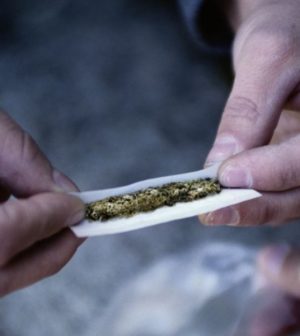- Navigating Your Midlife Crisis: Embracing New Possibilities
- City Raccoons Showing Signs of Domestication
- Mapping the Exposome: Science Broadens Focus to Environmental Disease Triggers
- One Week Less on Social Media Linked to Better Mental Health
- Your Brain Changes in Stages as You Age, Study Finds
- Some Suicide Victims Show No Typical Warning Signs, Study Finds
- ByHeart Formula Faces Lawsuits After Babies Sickened With Botulism
- Switch to Vegan Diet Could Cut Your Greenhouse Gas Emissions in Half
- Regular Bedtime Does Wonders for Blood Pressure
- Dining Alone Could Mean Worse Nutrition for Seniors
Teen Pot Use Fell in States That Legalized Medical Marijuana: Study

Marijuana legalization has been sweeping across the United States, raising concerns that more teens will start toking as pot smoking gains in legitimacy.
A new study suggests that’s not the case. Researchers actually found fewer teen marijuana users in states that have adopted medical marijuana laws.
States with medical marijuana laws had 1.1 percent fewer teenage pot smokers than states without such laws, researchers said.
“The shifts were small,” said lead researcher Rebekah Levine Coley, chair of counseling, developmental and educational psychology at Boston College’s Lynch School of Education and Human Development. “For every 100 adolescents, just over one fewer would report having used marijuana in the prior month following enactment of medical marijuana laws.”
But the patterns were larger among certain subgroups. “For example,” Coley said, “current use of marijuana decreased among male high school students by 2.7 percent. And use decreased by 3.9 percent among African-American students, and by 2.7 percent among Hispanic students.”
For the study, Coley’s team relied on data from the Youth Risk Behavior Survey, a poll conducted by the U.S. Centers for Disease Control and Prevention every other year. It tracks drinking, drug use and other risky activities among U.S. teens.
Researchers analyzed survey data gathered between 1999 through 2015 from 45 states, including more than 860,000 students.
Since the surveys covered more than 16 years, researchers were able to trace changes in teens’ pot use in states that adopted medical marijuana laws, and compare them to use in states where weed remained illegal.
Interestingly, the longer medical marijuana laws had been on the books, the less likely teenagers were to use pot — about 9 percent lower odds in states with laws five years old or fewer, compared with 32 percent lower odds if the law had been in effect for more than 10 years.
There are a couple of theories why this might be happening, Coley said.
“One is that medical marijuana laws change adolescents’ views of marijuana, supporting the view that it is a medicinal rather than a recreational drug,” Coley said.
“Another hypothesis is that as marijuana laws have become less restrictive, parents are paying more attention and providing more supervision to their teenagers, or talking more about the potential dangers of drug use,” she said.
Linda Richter, director of policy research and analysis for the Center on Addiction, was not involved with the new study, and questioned the validity of its conclusions.
“A statistically significant finding of a 1.1 percentage point lower rate of adolescent marijuana use in states with medical marijuana laws based on a sample as large as 861,082 respondents is all but meaningless,” she said.
“Importantly, the national study upon which these findings are based, the CDC’s Youth Risk Behavior Survey, does not include long-term data from early adopters of medical and recreational marijuana laws, like Colorado, Washington and Oregon, which other studies have found to have experienced increases rather than declines in adolescent marijuana use,” Richter added.
Coley and her team are now looking into whether states that have legalized recreational pot experienced the same effect they found with medical marijuana laws.
“We do not know whether adolescents will view the legalization of recreational marijuana the same way,” Coley said. “The law again only applies to adults aged 21 and above, but nonetheless, this shift in policy may alter how adolescents view marijuana and how accessible it is to them.”
Richter said we already have the answer, based on other research.
“Data from the National Survey on Drug Use and Health show that states that have legalized medical and recreational marijuana use have higher rates of reported use among teens aged 12 to 17 — way higher than the national average — and lower rates of teens reporting perceptions of risk or harm from the drug — way lower than the national average,” she said.
Richter said data can be parsed in many ways and it is important not to misrepresent data related to medical marijuana to sell the public on the benefits of legalizing recreational pot.
“Few would contend that teen marijuana use is healthy or desirable,” she said.
“While one can convincingly argue for the merits of medical marijuana laws to help sick people or for marijuana decriminalization to rectify decades of injustice to racial minorities, it truly defies logic to make the case that liberal marijuana laws help to dissuade young people from using the drug,” Richter said.
The new study is being published Feb. 15 in the American Journal of Drug and Alcohol Abuse.
More information
The U.S. Centers for Disease Control and Prevention have more about marijuana use in teens.
Source: HealthDay
Copyright © 2025 HealthDay. All rights reserved.










